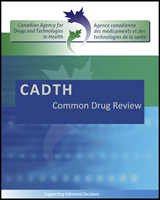The manufacturer submitted a cost-minimization analysis comparing rivaroxaban to enoxaparin (1.0 mg/kg twice daily for eight days) plus a vitamin K antagonist (VKA) (day 9 onward) for treatment of PE in Canada. Clinical evidence to support the use of a cost-minimization analysis was based on the EINSTEIN PE trial. The public payer’s perspective was taken in the analysis. Drug costs, patient monitoring, and drug administration costs were derived from Canadian sources. Drug costs were obtained from the Ontario Drug Benefit Formulary (February 2013), and drug administration costs were obtained from a Canadian cost-effectiveness study.1 An average low-molecular-weight heparin (LMWH) cost was calculated based on the assumed patient weight of 80 kg, based on recent venous thromboembolism trials (Manufacturer’s Pharmacoeconomic Submission, page 34).
Monitoring for rivaroxaban assumed one check-up visit per month for the first three months and one check-up visit per three-month period thereafter ($33.70 per visit, based on the Ontario Schedule of Benefits for Physician Services). For LMWH plus VKA monitoring costs, 19% of patients receiving a LMWH as an outpatient would require nurse assistance after discharge from hospital.1 The monitoring cost for warfarin included cost of physician consultations or anticoagulation clinic consultation and prothrombin time (PT) tests, and was derived from a Canadian costing study on warfarin management.2 It was assumed that patients receiving VKA would require eight visits to monitor PT and warfarin dose titration in the first three months, and one visit per month thereafter. The cost per visit, including all PT testing, was obtained from this Canadian costing study:2 $15.95 for anticoagulation clinic consultation (5% of patients) and $46.52 for general practitioner (GP) or community setting (95% of patients).
In the base case, the manufacturer considered treatment durations of three to 36 months, based on the assumption that rivaroxaban has equivalent clinical efficacy and safety compared with enoxaparin plus VKA at all time points. The manufacturer also performed sensitivity analyses on the following parameters: once daily dose of enoxaparin, enoxaparin duration (five and 10 days), and monitoring costs (± 50%).
In the , the manufacturer reported that rivaroxaban had greater drug acquisition costs than LMWH plus VKA at all time points ($295 versus $273 at three months; $2,346 versus $322 at 36 months), but monitoring costs were less ($89 versus $360 at three months; $356 versus $1,428 at 36 months). Rivaroxaban was cost saving compared with enoxaparin plus VKA for a treatment duration of three (−$249) and six months (−$113). From 12 to 36 months of treatment, rivaroxaban would incur additional costs of $152 to $952.
Manufacturer’s Base-Case Analyses.
The manufacturer also submitted a series of sensitivity analyses (). When one daily dose of LMWH was considered in an alternative scenario, the cost saving of rivaroxaban persisted but was lower (−$182 and −$46 for the three- and six-month treatment durations, respectively). When LMWH was used for five days instead of eight days, as in the base case, rivaroxaban was no longer cost saving at six months (additional cost of $4). Rivaroxaban total costs were also greater ($68) at six months when the monitoring cost (for both treatment strategies) was reduced by 50%. In contrast, when increasing the monitoring cost by 50%, rivaroxaban was cost saving at three, six, and 12 months (with a saving from $117 to $385).
Manufacturer’s Sensitivity Analyses (Incremental Total Cost).

